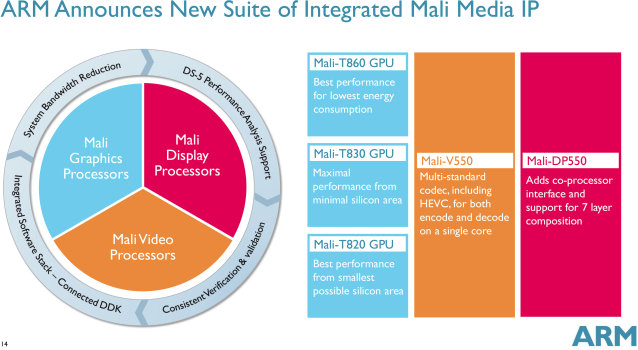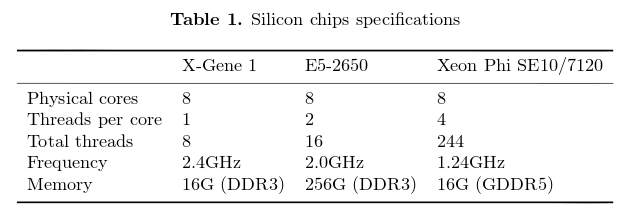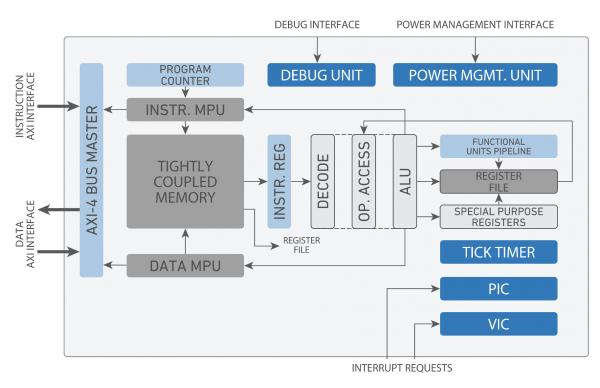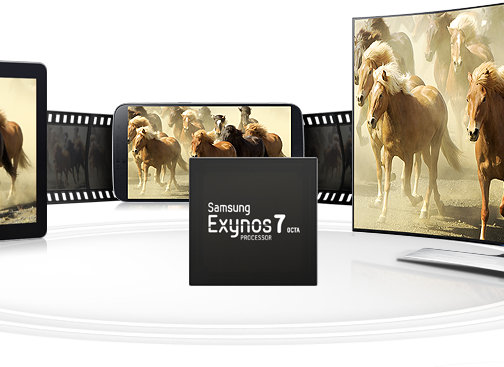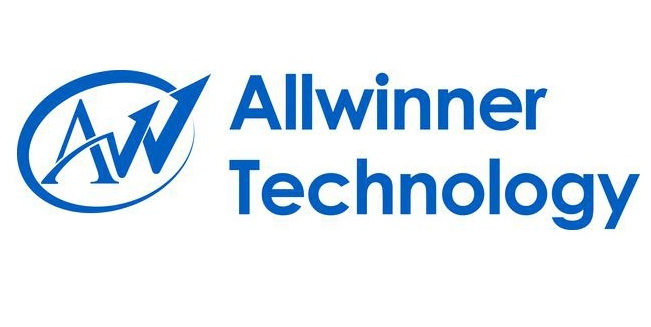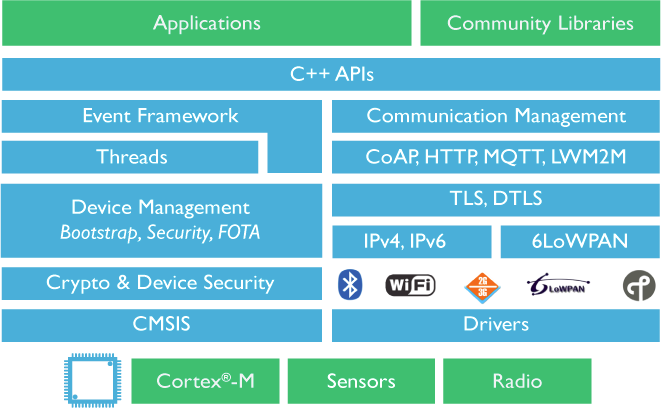ARM has just announced several new Mali media IP: three Mali-T800 series GPUs (Mali-T820, Mali-T830, and Mali-T830) based on Midgard architecture, as well as Mali-V500 video accelerator, and the Mali-DP550 display processor. Mali T800 Series GPU The new Mali T-8xx GPUs are based on the same Midgard architecture used in Mali T-6xx and T-7xx GPUs, but deliver better power efficiency thanks to technologies such as ARM Frame Buffer Compression (AFBC), and Adaptive Scalable Texture Compression (ASTC) for imput bandwidth reduction, as well as Transaction Elimination and Smart Composition. ARM provided some performance and energy-comparison between T800 and T600 series (but strangely nothing against T700): The Mali-T820 GPU is optimized for entry-level products, achieving up to 40 percent more performance density compared to the Mali-T622 GPU. The Mali-T830 GPU delivers up to 55 percent more performance than the Mali-T622 GPU. The Mali-T860 GPU provides higher performance and 45 percent more energy-efficiency […]
Applied Micro X-Gene (64-bit ARM) vs Intel Xeon (64-bit x86) Performance and Power Usage
A group of researcher at CERN have evaluated Applied Micro X-Gene 1 64-bit ARM XC-1 development board against Intel Xeon E5-2650 and Xeon Phi SE10/7120 systems, and one of them, David Abdurachmanov, presented their findings at ACAT’ 14 conference (Advanced Computing and Analysis Techniques) by listing some of the issues they had to port their software to 64-bit ARM, and performance efficiency of the three systems for data processing of High Energy Physics (HEP) experiments like those at the Large Hadron Collider (LHC), where performance-per-watt is important, as computing systems may scale to several hundred thousands cores. Intel Xeon Phi platform based on Many Integrated Cores (MIC) computer architecture was launched the HPC market, and contrary to the table above features 61 physical cores. Applied X-Gene 1 (40nm process) was used instead of X-Gene 2 built on 28-nm process which was not available at the time. The ARM platform ran […]
Beyond Semi Introduces 32-bit BA20 Core with Cortex M4 Performance Efficiency, and Cortex M0+ Silicon Area
Beyond Semiconductor and CAST have jointly announced BA20 32-bit embedded processor core with PipelineZero Architecture (zero-stage execution pipeline), that rivals with ARM Cortex A4 in terms of performance per MHz, while using about the same silicon area as an ARM Cortex M0+. which could be critical for applications such as wearables, sensors, and wireless communication, that may require both a small footprint and high performance efficiency. The company’s PipelineZero micro-archirtecture can execute one instruction per cycle, hence saving energy by doing more in less time, and by operating at lower clock rates. Key features listed for BA20 IP core: PipelineZero architecture for high performance efficiency with tiny silicon footprint 3.04 DMIPs/MHz (vs ARM Cortex M4: 1.25 DMIPS/MHz) 3.41 Coremarks/MHz (vs ARM Cortex M4: 3.40 CoreMarks/MHz) 2µW/MHz (vs ARM Cortex M0+: 3µW/MHz) 10K gates (0.01mm2) in 9-track 40G (vs 0.009mm2 for ARM Cortex M0+) BA2 ISA Extreme Code Density for less […]
Samsung Officially Announces Exynos 7 Octa big.LITTLE ARM Cortex A53/A57 Processor
Samsung started to commit code related to Exynos 7 processor to mainline kernel in August, but at the time details were scarce, and many tech websites referred to a Exynos 5433 64-bit processor from Samsung. Exynos 5433 for a Cortex A53/A57 SoC did not make much sense as the company recently announced Exynos 5430 based on Cortex A15 and A7 cores, so finally Exynos 5433 has been renamed to Exynos 7 Octa. Here’s what we know about Exynos 7 Octa from information on Exynos 7 Octa page and an older Anandtech article about Exynos 5433: CPU – 4x Cortex A57 cores @ 1.9 GHz , 4x Cortex A53 cores @ 1.3 GHz GPU – Mali-T760 @ 700 MHz Memory Controller – 2x 32-bit @ 825MHz (13.2GB/s b/w) Display – Up to WQHD (2560 x 1440) / WQXGA (2560 x 1600) resolutions Video – Advanced multimedia format codec (MFC) including support […]
Allwinner H8 Octa-core Processor is Designed for Game Consoles and OTT Boxes
Allwinner Technology has just introduced its new octa-core H8 System on Chip (SoC) for “high-end” gaming consoles and video OTT (over-the-top) boxes, right before the Hong Kong Electronics Fair taking place on October 13-16. The processor feature eight Cortex A7 cores clocked at up to 2.0 GHz, coupled with Imagination Technology PowerVR SGX544 GPU @ 700 MHz with support for OpenGL ES 2.0/1.1, OpenCL 1.1 APIs. Other key features includes: Multi-format 1080p@60fps video processing including H.265/HEVC codec. HDMI video output up to 1080P@60fps, with HDCP 2.0 support; support HDMI CEC Integrated 8M image signal processor USB – USB Host, and USB dual-role interfaces Gigabit Ethernet MAC Three SD/MMC controllers SmartColor technology to deliver higher image quality and better visual effects Manufactured with 28nm HPC (High-Performance Compact) process by TSMC. We don’t have the full details, but it does look very similar to Allwinner A83T announced last month, but except of […]
Linux 3.17 Released
Linus Torvalds announced the release of Linux Kernel 3.17 on Sunday: So the past week was fairly calm, and so I have no qualms about releasing 3.17 on the normal schedule (as opposed to the optimistic “maybe I can release it one week early” schedule that was not to be). However, I now have travel coming up – something I hoped to avoid when I was hoping for releasing early. Which means that while 3.17 is out, I’m not going to be merging stuff very actively next week, and the week after that is LinuxCon EU… What that means is that depending on how you want to see it, the 3.18 merge window will either be three weeks, or alternatively just have a rather slow start. I don’t mind getting pull requests starting now (in fact, I have a couple already pending in my inbox), but I likely won’t start processing […]
ARM Announces mbed OS for ARM Cortex-M Micro-controllers and mbed Device Server for the Cloud
ARM has just announced two new software products for mbed development boards at ARM Techcon 2014: mbed OS, an operating system for Cortex-M MCUs, and mbed Device Server to handle IoT data in the cloud. Together with existing mbed hardware, these form what ARM now calls mbed IoT Device Platform. mbed OS is a free operating system for ARM Cortex-M processor with security, communication and device management features necessary to enable IoT devices. It will provide a C++ application framework, and the software stack includes support for Bluetooth Smart, 2G, 3G, LTE and CDMA cellular technologies, Thread, Wi-Fi, 802.15.4 / 6LoWPAN, TLS/DTLS, CoAP, HTTP, MQTT and Lightweight M2M. No need to look for your mbed board, planning to try it out just yet however, as mbed OS (alpha) will be available to partners in Q4 2014, and there will be alpha and beta releases during the course of 2015, before […]
STMicro STM32F4 (Cortex M4) vs STM32F7 (Cortex M7) Graphics Demo
STMicro announced their latest STM32F7 micro-controller family based on ARM Cortex M7 last week. As ARM Techcon 2014 is now taking place, the company has uploaded an infomercial on their YouTube account, where STMicro and ARM representatives are interviewed about the new family, and talk about its performance, power consumption, target applications, business prospects, and so on. But there’s also an a short demo with two development kits one with a STM32F4 cortex M4 micro-controller, and the other with a STM32F7 micro-controllers. Since both MCU families are pin-to-pin compatible, the hardware is identical except for the MCU. Both kits are pre-loaded with a 3D graphics demo (ray tracer), and the board with STM32F7 completes the demo in about half the time of the one with STM32F439, allegedly with about the same power consumption (7 coremarks / mW). The video is about 8 minutes long, and the demo starts at 1:25. […]


